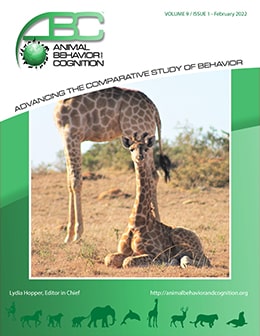Vol 9, Issue 1, February 2022
Do Bats use Scent Cues from Guano and Urine to Find Roosts?
Citation
Brown, B. K. G., & Carter, G. G. (2022). Do bats use scent cues from guano and urine to find roosts? Animal Behavior and Cognition, 9(1), 106-118. https://doi.org/10.26451/abc.09.01.09.2022
Abstract
Selection of habitat is a key determinant of reproductive success, and the process of finding and choosing these sites is often influenced by the presence of conspecifics. Many bats frequently switch roosts, and some bats repeatedly find new roosts. To find roosts with conspecifics or group members, bats can use social cues. However, most research on how bats use social cues for roost-finding has focused on acoustic cues. Here, we review and discuss the evidence for bat roost selection using scent cues from guano and urine stains, which are present at most bat roosts. We outline reasons why bats might, or might not, use scent in roost detection and selection, and we review evidence on the possible use of guano and urine in roost-finding from eight studies with 12 bat species (across four families). Overall, the sparse evidence that exists indicates that scent cues from guano and urine are not a strong and consistent lure in the species and situations that were tested. Most studies had unclear results or found no effect. Two of the eight studies found weak experimental evidence for bats using guano or urine to select a roosting site. Even if guano and urine can indicate the presence of bats at a roost, it is possible that the resulting olfactory cues do not contain sufficient social information to be used in roost selection, in contrast to olfactory cues from scent marking. Studies of how bats use sensory cues beyond sound could contribute to a better understanding of bat social behavior and roosting ecology.
Keywords
Bats, Roosting ecology, Sensory ecology, Olfaction
